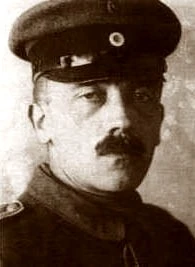
Hitler in the First World War
Adolf Hitler (1889-1918) was an Austrian-born German soldier who was killed in the First World War. He was an unsuccessful artist living in Munich who was rejected by the Academy of Fine Arts Vienna twice. Having stayed in Vienna when the antisemitic mayor Karl Lueger was in office, Hitler was believed to be an antisemite himself. He joined the army at the outbreak of the First World War and was eventually killed outside the village of Marcoing in the fall of 1918.
Early Life[]
Adolf was born on April 20, 1889 in the small Austro-Hungarian village of Ranshofen, which was later incorporated into the town of Braunau am Inn, the fourth of six children born to Alois and Klara Hitler. Young Adolf was sickly as a baby, and his mother fretted over him. Alois, however, showed almost no interest in raising him and left it all to Klara. As he grew up, Hitler often clashed with his father, who did not approve of his son's interest in the fine arts.
Adulthood[]
In 1903, Alois died suddenly. Two years later, Adolf’s mother allowed her son to drop out of school. At age 16, he moved to Vienna and worked as a casual laborer and a watercolor painter. He applied to the Academy of Fine Arts twice, but was rejected both times. He was forced to live in a homeless shelter for several years. It is during this time that Hitler's antisemitism first cultivated. In May 1913, he moved to Munich in Germany.
First World War[]

Hitler along with some other German soldiers
Following Archduke Franz Ferdinand's assassination and the outbreak of the First World War, Adolf applied to join the Bavarian Army despite the fact that he was still holding Austrian citizenship. It was during this time that he began to develop German nationalist ideas.
Hitler served in France and Belgium in the 16th Bavarian Reserve Regiment. He was promoted once to the rank of Gefreiter, but he was deemed to not be officer material, with very little chance of advancing any more. He was present at a number of famous battles, such as the First Battle of Ypres, the Battle of the Somme, the Battle of Arras, and the Battle of Passchendaele. At Ypres, Hitler witnessed the deaths of tens of thousands of men. His own company was reduced from 250 men to 42.
He received two awards for bravery. In 1914, he was given the somewhat common Iron Cross, Second Class. However, in 1918, he received the Iron Cross, First Class. This was rare, especially for a Gefreiter.
Death[]
Near the war's end, Hitler was sent to the French village of Marcoing. There, he was wounded and stumbled across British Private Henry Tandey. Tandey aimed at 29-year-old Hitler and fired. Tragically, Adolf Hitler died instantly.
